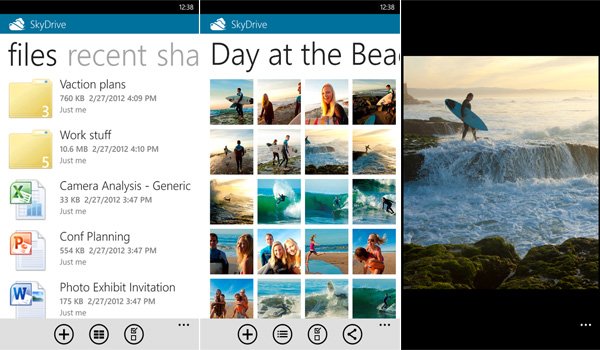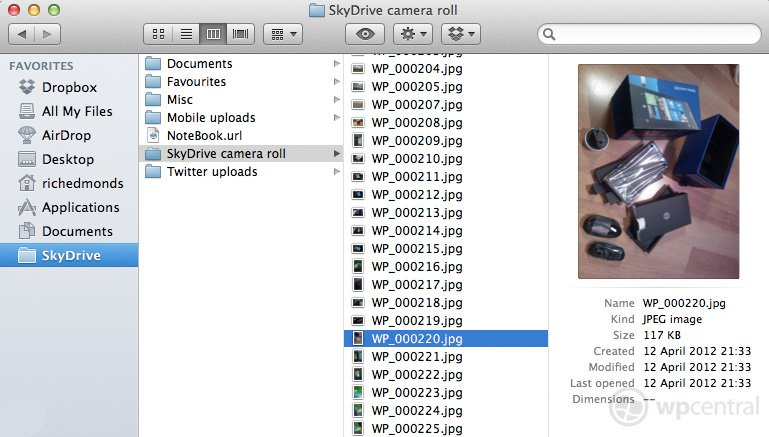Making the most of cloud storage with SkyDrive on your Windows Phone
Curious about how SkyDrive can make your life more useful? Read our guide to find out.

Cloud storage is becoming more and more mainstream, especially among smartphone and tablet owners where local storage is limited. Storing data in the clouds (remotely hosted servers) enables the owner to access data from any supported location. DropBox is probably the best known example of cloud storage for PC users with native clients available for both Windows and Mac.
Microsoft has its own cloud storage solution, but how does SkyDrive compare to competitors? We'll take a quick glance at some features of Microsoft's product against Dropbox, Apple's iCloud and Google Drive. Microsoft has also published a chart of their own, which offers a more in-depth comparison.
| SkyDrive | DropBox | iCloud | Drive | |
| Free Storage | 7GB* | 2.5GB | 5GB | 5GB |
| Price | +20GB - $10/yr +50GB - $25/yr +100GB - $50/yr | 50GB - $99/yr 100GB - $199/yr | 10GB - $20/yr 20GB - $40/yr 50GB - $100/yr | 25GB - $2.49/mo 100GB - $4.99/mo ~16TB available |
| Platforms | iOS, Mac, PC, WP | Droid, iOS, Mac, PC, WP | iOS, Mac | Droid, Mac, PC |
*25GB is available for existing users.
According to the table above, SkyDrive is a more attractive option compared to competitors, but what about Windows Phone? Microsoft has developed its own cloud storage solution that was formed with the Live umbrella of products, and its fully integrated into Windows Phone with a complimentary app to go with. But where exactly is this integration?
Windows Phone
As well as contacts, email and calendar being handled by the cloud backend of the Live service, SkyDrive can be found within a number of stock apps on Windows Phone. Once the Live ID has been setup on the phone and connected to Microsoft's servers via an Internet connection, the Windows Phone will be able to pull down all content stored on that account.
The Microsoft Office hub synchronises notes with those stored on SkyDrive, which can also be read and edited using the native clients for Windows and Mac. We published a OneNote tutorial that will prove useful should you encounter issues with synchronisation between SkyDrive and Windows Phone. We don't halt at just notes though as the Office hub can also pull down Microsoft Office documents from SkyDrive for local editing while on the go.
All the latest news, reviews, and guides for Windows and Xbox diehards.
The other location in Windows Phone that makes use of SkyDrive integration is the Pictures hub, which -as you probably have guessed already- brings down photos from your SkyDrive account. As well as this, the camera app can be configured to automatically upload snaps straight to the cloud for secure storage.
Tip: 'Settings > applications > pictures + camera', then select "Automatically upload to SkyDrive" to enable Windows Phone to upload photos to SkyDrive as soon as the shot has been saved locally on the device.
Integration is not the only way to access SkyDrive as Microsoft has released a dedicated SkyDrive app for Windows Phone, which keeps everything in one place. It's the one stop for browsing everything that's stored on the account once logged in. A handy feature of the app is different Live IDs can log in for access to different account. This isn't possible with the built-in functionality as the single Live ID is integrated into the Windows Phone.
Once download, the SkyDrive app enables users to browse their account in its entirety. Photos can be viewed as one would expect in the Pictures Hub. As Windows Phone sports Microsoft Office built-in, supported documents can be opened, edited and saved while on the go without using a third-party app. Permission settings can be configured within the app for folders and files. For more convenient access, recently viewed files are displayed in their own pane and any shared files are viewable as an added bonus.
This wouldn't be a particularly useful official offering from Microsoft if management of files and folders weren't possible. Users can move, delete, rename and create new folders in the SkyDrive app that will then take effect on the account. Should you use SkyDrive enough, you'll need this app.
Windows & Mac
Microsoft has developed two native desktop clients for SkyDrive - one for Windows and the other for Mac. The software giant has done an exceptional job at enabling Mac users to come aboard the Windows Phone train with not only a SkyDrive app, but the Windows Phone Connector too. Both SkyDrive apps for Windows and Mac work in similar ways. SkyDrive creates a folder where all contents on that Live ID are displayed for browsing / editing and more.
Once the app is installed and the Live ID is attached, the app will synchronise all folders and files from the cloud to the computer for local access. All changes made using these clients will reflect on both the web and Windows Phone, making editing and sharing Microsoft Office documents a breeze. You can download the Windows and Mac clients from the SkyDrive website.
To sum up SkyDrive as a service, it can prove invaluable to those who enjoy keeping personal files safe in the cloud, which can be accessed from multiple locations and devices. With the competitive pricing, clients for popular platforms and the large brand name to back the service, SkyDrive is a perfect cloud storage solution for Windows Phone users.
You can find more on Microsoft's SkyDrive services here at the SkyDrive website and download the SkyDrive app (free) here at the Windows Phone Marketplace.

Rich Edmonds was formerly a Senior Editor of PC hardware at Windows Central, covering everything related to PC components and NAS. He's been involved in technology for more than a decade and knows a thing or two about the magic inside a PC chassis. You can follow him on Twitter at @RichEdmonds.



